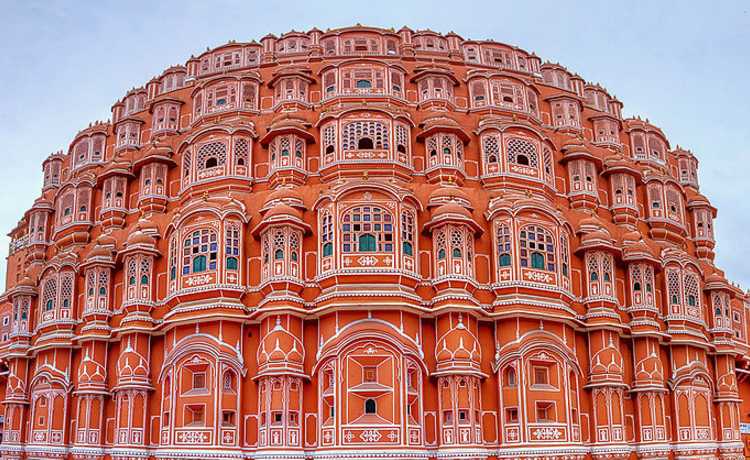
Jaipur-Book a Trip
JAIPUR-THE PINK CITY
Planned by Vidyadhar Bhattacharya, Jaipur holds the distinction of being the first planned city of India. Renowned globally for its coloured gems, the capital city of Rajasthan combines the allure of its ancient history with all the advantages of a metropolis. The bustling modern city is one of the three corners of the golden triangle that includes Delhi, Agra and Jaipur.
The story goes that in 1876, the Prince of Wales visited India on a tour. Since the colour pink was symbolic of hospitality, Maharaja Ram Singh of Jaipur painted the entire city pink. The pink that colours the city makes for a marvellous spectacle to behold. Jaipur rises up majestically against the backdrop of the forts Nahargarh, Jaigarh and Garh Ganesh Temple.
Jaipur traces back its origins to 1727 when it was established by Jai Singh II, the Raja of Amber. He shifted his capital from Amber to the new city because of the rapidly-growing population and an increasing water scarcity. Noted architect Vidyadhar Bhattacharya used the established principles of Vastu Shastra to build the city.
ADDITIONAL INFO
AMBER PALACE
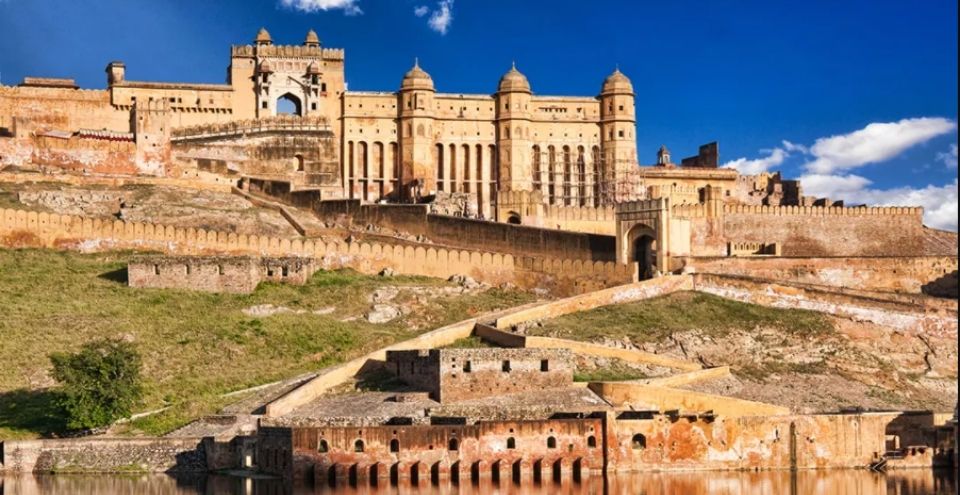 Amber (pronounced Amer) is at a distance of about 11 kilometres from Jaipur. Now a UNESCO World Heritage Site, it was the bastion of the Kachwahas of Amber, until the capital was moved to the plains, to what is today Jaipur. The palace, located in craggy hills, is a beautiful melange of Hindu and Mughal styles. Raja Man Singh I began construction in 1592 and the palace, which was built as a strong, safe haven against attacking enemies, was completed by Mirja Raja Jai Singh. The contrast between the harsh exterior and the inviting interior couldn’t be more surprising. Made entirely of red sandstone and white marble, visitors are left spellbound by the magnificence of the palace that utilises carvings, precious stones and mirrors. The splendour of the palace is enhanced by the breath-taking vista of the Maota Lake in front. The palace is nearly seven centuries old and has a legendary past. Originally a small structure that the Rajputs won from the Meena tribes, it was later transformed into the grand Amber Palace.
Amber (pronounced Amer) is at a distance of about 11 kilometres from Jaipur. Now a UNESCO World Heritage Site, it was the bastion of the Kachwahas of Amber, until the capital was moved to the plains, to what is today Jaipur. The palace, located in craggy hills, is a beautiful melange of Hindu and Mughal styles. Raja Man Singh I began construction in 1592 and the palace, which was built as a strong, safe haven against attacking enemies, was completed by Mirja Raja Jai Singh. The contrast between the harsh exterior and the inviting interior couldn’t be more surprising. Made entirely of red sandstone and white marble, visitors are left spellbound by the magnificence of the palace that utilises carvings, precious stones and mirrors. The splendour of the palace is enhanced by the breath-taking vista of the Maota Lake in front. The palace is nearly seven centuries old and has a legendary past. Originally a small structure that the Rajputs won from the Meena tribes, it was later transformed into the grand Amber Palace.
CITY PALACE
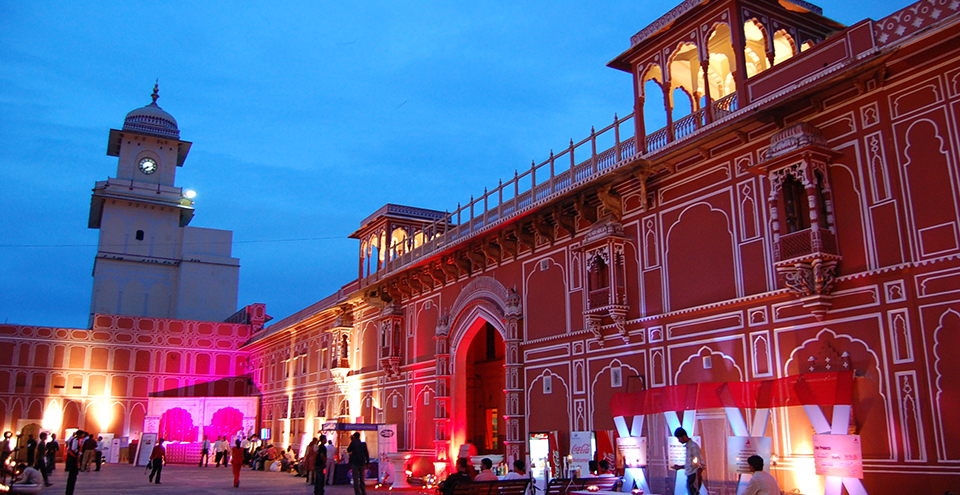 Located deep within the walled city, the City Palace Complex was conceived and built by Maharaja Sawai Jai Singh II, the founder of Jaipur. A beautiful fusion of Mughal and Rajput architecture, the palace is still home to the last ruling royal family which lives in a private section of the palace. Maharaja Sawai Jai Singh II is credited with building most of the structures, but it was expanded upon by later rulers as well. The City Palace Complex includes the Mubarak Mahal (the palace of reception) and the Maharani’s Palace (the palace of the queen). Mubarak Mahal now houses the Maharaja Sawai Man Singh II Museum and displays a vast and unique collection of royal costumes, delicate Pashmina (Kashmiri) shawls, Benaras silk saris, and other dresses with Sanganeri prints and folk embroidery. The clothes of Maharaja Sawai Madho Singh I are also on display. The Maharani’s Palace, surprisingly, has an interesting display of very well-preserved Rajput weaponry, some dating back to the 15th century. Other than the arms, the palace is adorned with beautiful paintings on the ceiling that are well-maintained.
Located deep within the walled city, the City Palace Complex was conceived and built by Maharaja Sawai Jai Singh II, the founder of Jaipur. A beautiful fusion of Mughal and Rajput architecture, the palace is still home to the last ruling royal family which lives in a private section of the palace. Maharaja Sawai Jai Singh II is credited with building most of the structures, but it was expanded upon by later rulers as well. The City Palace Complex includes the Mubarak Mahal (the palace of reception) and the Maharani’s Palace (the palace of the queen). Mubarak Mahal now houses the Maharaja Sawai Man Singh II Museum and displays a vast and unique collection of royal costumes, delicate Pashmina (Kashmiri) shawls, Benaras silk saris, and other dresses with Sanganeri prints and folk embroidery. The clothes of Maharaja Sawai Madho Singh I are also on display. The Maharani’s Palace, surprisingly, has an interesting display of very well-preserved Rajput weaponry, some dating back to the 15th century. Other than the arms, the palace is adorned with beautiful paintings on the ceiling that are well-maintained.
JANTAR MANTAR
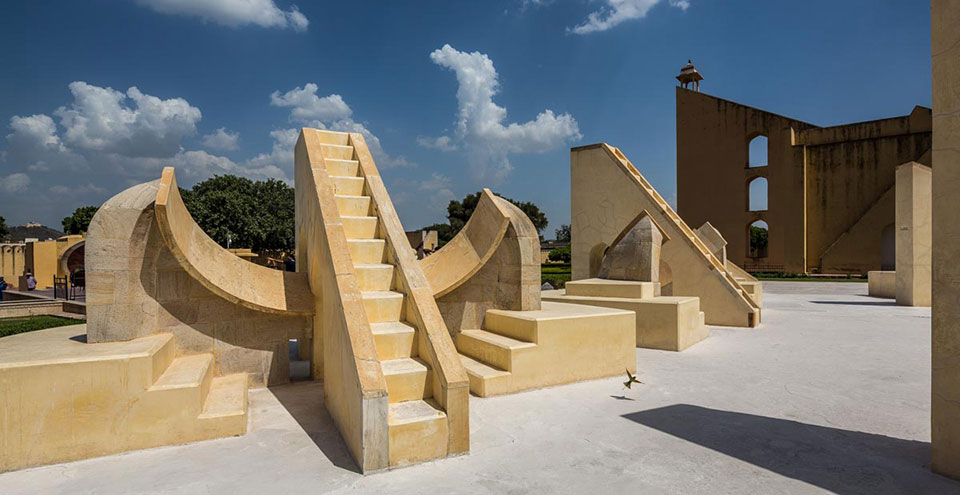 Now a UNESCO World Heritage Site, Jantar Mantar in Jaipur is considered to be the largest of the five astronomical observatories built by Maharaja Sawai Jai Singh II, the founder of Jaipur. It contains sixteen geometric devices, designed to measure time, track celestial bodies and observe the orbits of the planets around the sun. It also houses the Interpretation Centre that helps the tourists to understand about the working principles & chronolgy of the observatory.
Now a UNESCO World Heritage Site, Jantar Mantar in Jaipur is considered to be the largest of the five astronomical observatories built by Maharaja Sawai Jai Singh II, the founder of Jaipur. It contains sixteen geometric devices, designed to measure time, track celestial bodies and observe the orbits of the planets around the sun. It also houses the Interpretation Centre that helps the tourists to understand about the working principles & chronolgy of the observatory.
HAWA MAHAL
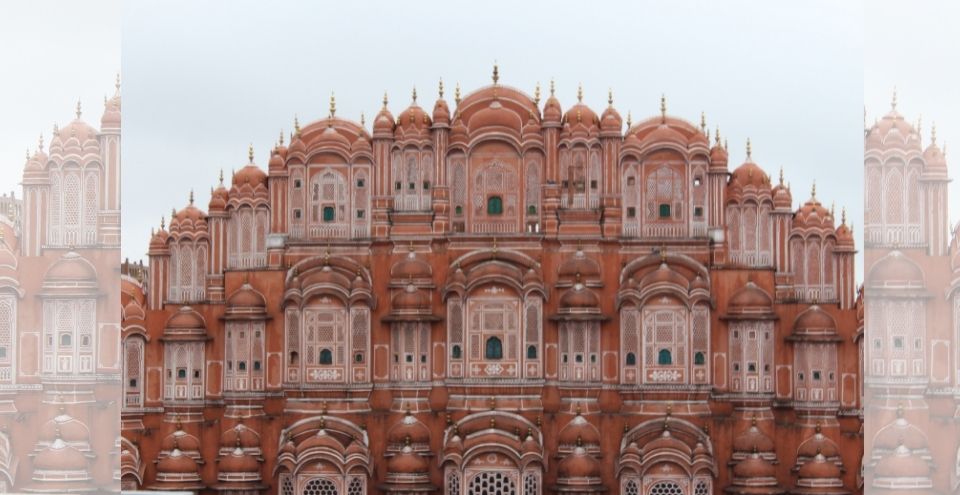 Hawa Mahal, literally the Palace of Winds, was built in 1799 by the poet king Sawai Pratap Singh as a summer retreat for him and his family. It also served as a place where the ladies of the royal household could observe everyday life without being seen themselves. This unique five-storey structure is a blend of Hindu and Islamic architecture, and the exterior, with its small latticed windows (called jharokhas), resembles the crown of Lord Krishna. The windows also serve as an air-conditioner of sorts, blowing cool air throughout the palace, making it the perfect retreat during summers. Built from pink sandstone, the Hawa Mahal is Jaipur’s iconic landmark and visitors can view its complete magnificence from outside, from across the road. However, it is also possible to climb right up to the top for a wonderful view from the windows. Today, the Mahal is maintained by the Archaeological Department of the Government of Rajasthan and also houses an archaeological museum in the courtyard.
Hawa Mahal, literally the Palace of Winds, was built in 1799 by the poet king Sawai Pratap Singh as a summer retreat for him and his family. It also served as a place where the ladies of the royal household could observe everyday life without being seen themselves. This unique five-storey structure is a blend of Hindu and Islamic architecture, and the exterior, with its small latticed windows (called jharokhas), resembles the crown of Lord Krishna. The windows also serve as an air-conditioner of sorts, blowing cool air throughout the palace, making it the perfect retreat during summers. Built from pink sandstone, the Hawa Mahal is Jaipur’s iconic landmark and visitors can view its complete magnificence from outside, from across the road. However, it is also possible to climb right up to the top for a wonderful view from the windows. Today, the Mahal is maintained by the Archaeological Department of the Government of Rajasthan and also houses an archaeological museum in the courtyard.
ALBERT HALL MUSEUM (CENTRAL MUSEUM)
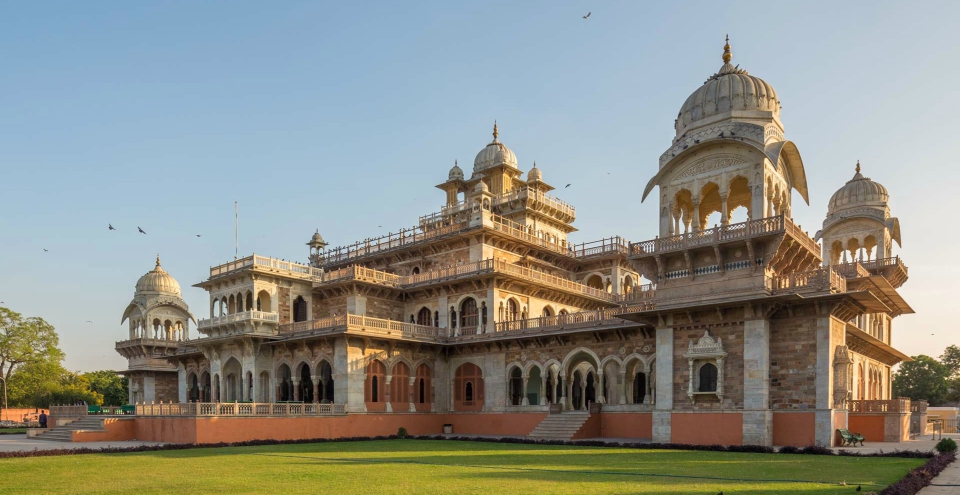 The building gets its name from The Victoria and Albert Museum in London, the inspiration for its design. The exquisitely built Albert Hall is housed in the centre of Ram Niwas Garden. Sir Swinton Jacob (who is also the mastermind behind many other palaces in Rajasthan) conceptualised and designed it using styles from the Indo-Sarcenic architecture and the Prince of Wales laid the foundation stone of the building in 1876. The museum displays a wide range of metal objects, wood crafts, carpets, stone and metal sculptures, arms and weapons, natural stones and ivory goods. It also houses a large collection of miniatures from Bundi, Kota, Kishangarh, Udaipur and Jaipur schools of art. vc_empty_space height=”30px”]
The building gets its name from The Victoria and Albert Museum in London, the inspiration for its design. The exquisitely built Albert Hall is housed in the centre of Ram Niwas Garden. Sir Swinton Jacob (who is also the mastermind behind many other palaces in Rajasthan) conceptualised and designed it using styles from the Indo-Sarcenic architecture and the Prince of Wales laid the foundation stone of the building in 1876. The museum displays a wide range of metal objects, wood crafts, carpets, stone and metal sculptures, arms and weapons, natural stones and ivory goods. It also houses a large collection of miniatures from Bundi, Kota, Kishangarh, Udaipur and Jaipur schools of art. vc_empty_space height=”30px”]
NAHARGARH FORT
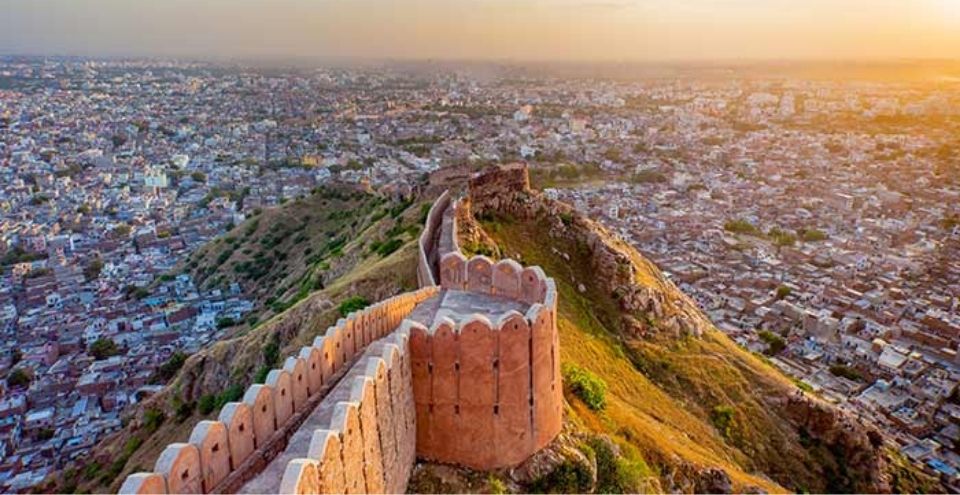 Nahargarh Fort sits proudly on a ridge of the Aravalli Hills, creating an impressive northern backdrop to the city of Jaipur. It was constructed during the reign of Jai Singh in 1734, and was later expanded in 1868. Nahargarh, which means abode of tigers, was a formidable barrier, defending Jaipur against attacking enemies. Within its walls, the fort houses Madhavendra Bhawan, the summer destination for the members of the royal family. Built by Sawai Madho Singh, the palace has 12 matching boudoirs for the queens, at the head of which is a suite for the king. They are all connected by corridors decorated with delicate murals. Even today the palace is a favoured spot for local picnickers. The fort looks brilliant when floodlit at night. Overlooking the city, it presents a glittering view of the city lights.
Nahargarh Fort sits proudly on a ridge of the Aravalli Hills, creating an impressive northern backdrop to the city of Jaipur. It was constructed during the reign of Jai Singh in 1734, and was later expanded in 1868. Nahargarh, which means abode of tigers, was a formidable barrier, defending Jaipur against attacking enemies. Within its walls, the fort houses Madhavendra Bhawan, the summer destination for the members of the royal family. Built by Sawai Madho Singh, the palace has 12 matching boudoirs for the queens, at the head of which is a suite for the king. They are all connected by corridors decorated with delicate murals. Even today the palace is a favoured spot for local picnickers. The fort looks brilliant when floodlit at night. Overlooking the city, it presents a glittering view of the city lights.
JAIGARH FORT
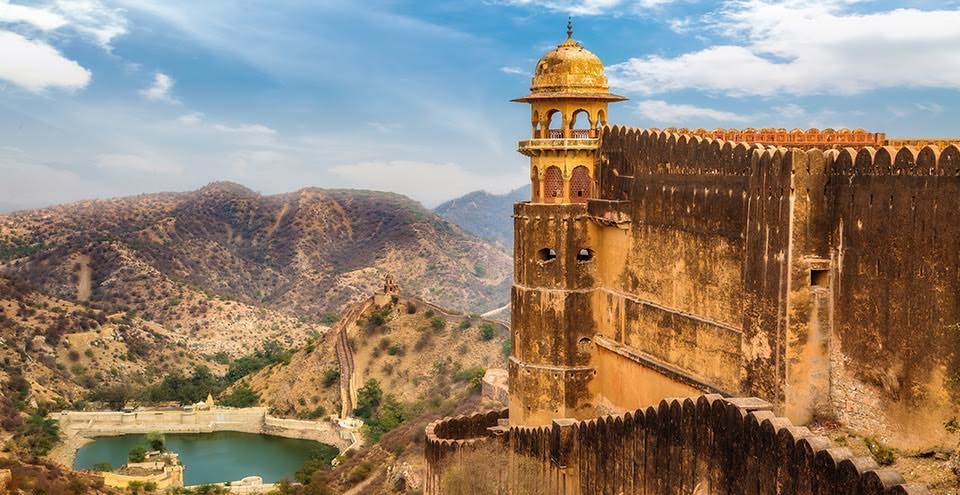 About 15 kilometres from Jaipur, Jaigarh Fort was built by Sawai Jai Singh II sometime in the early 18th century amidst the arid, rocky and thorn-scrub covered hills. Despite its ancient construction, it still retains most of its imposing citadel appearance. Visitors can see the world’s largest cannon – Jaiban, at the fort.
About 15 kilometres from Jaipur, Jaigarh Fort was built by Sawai Jai Singh II sometime in the early 18th century amidst the arid, rocky and thorn-scrub covered hills. Despite its ancient construction, it still retains most of its imposing citadel appearance. Visitors can see the world’s largest cannon – Jaiban, at the fort.
JAL MAHAL
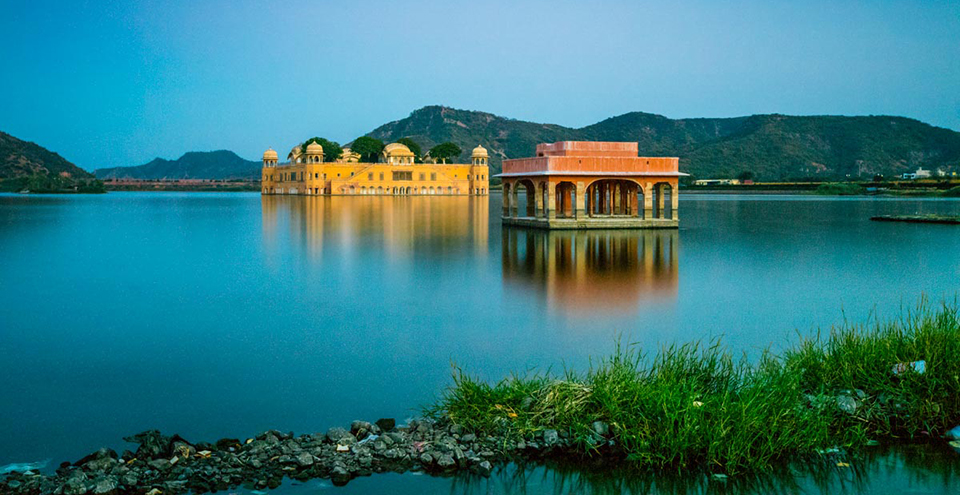 One of the most wonderful sights in Jaipur is the beautiful Jal Mahal or Lake Palace. The light, sand coloured stone walls and the deep blue of the water make for a wonderful contrast. The palace appears to float in the centre of Man Sagar Lake, where its magnificent exteriors can be enjoyed by tourists.
One of the most wonderful sights in Jaipur is the beautiful Jal Mahal or Lake Palace. The light, sand coloured stone walls and the deep blue of the water make for a wonderful contrast. The palace appears to float in the centre of Man Sagar Lake, where its magnificent exteriors can be enjoyed by tourists.
SISODIA RANI PALACE AND GARDEN
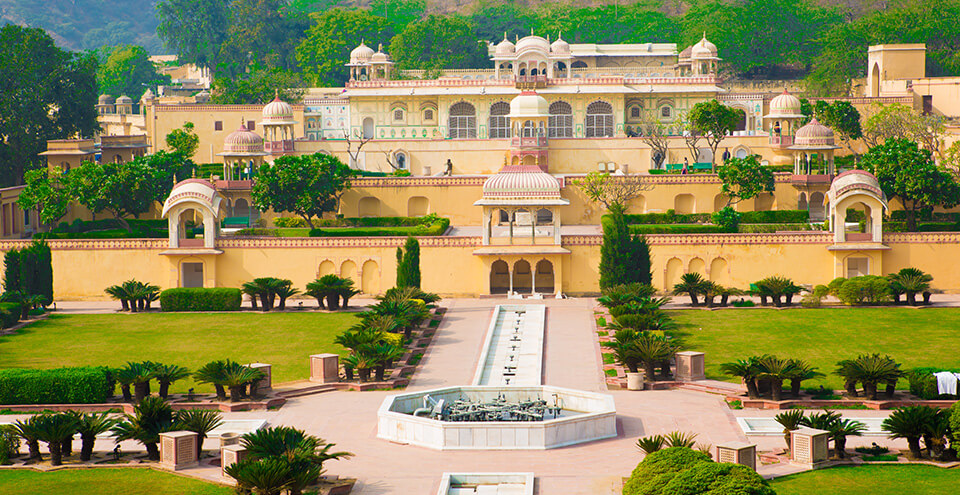 Sisodia Rani Palace and Garden is located 8 kilometres from Jaipur on the Agra road. Laid out in Mughal style, it is painted with the legends of Radha and Krishna. The garden is multi-tiered and has fountains, water courses and painted pavilions. Maharaja Sawai Jai Singh II built it for his Sisodia queen.
Sisodia Rani Palace and Garden is located 8 kilometres from Jaipur on the Agra road. Laid out in Mughal style, it is painted with the legends of Radha and Krishna. The garden is multi-tiered and has fountains, water courses and painted pavilions. Maharaja Sawai Jai Singh II built it for his Sisodia queen.
GALTAJI
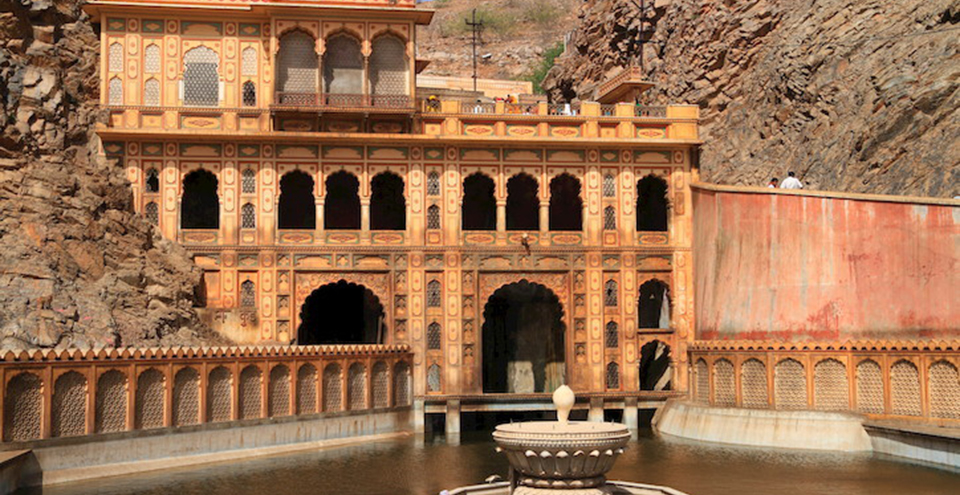
Galtaji Tempel
Galtaji is an ancient pilgrimage centre in Jaipur. Set amidst low hills and packed with locals and tourists alike, the attractive spot has temples, pavilions and holy kunds (natural springs and water tanks). Visitors to Galtaji will come across the complex of Ramgopalji temple, locally called the Monkey temple (Galwar Bagh). It gets this moniker because of a large group of resident monkeys. The green landscape and chattering monkeys add to the delight of the area. On top of the hill is a small temple dedicated to the sun god, called the Surya Mandir. Constructed by Diwan Kriparam, the temple can be seen from anywhere in the city.
MADHVENDRA PALACE, NAHARGARH
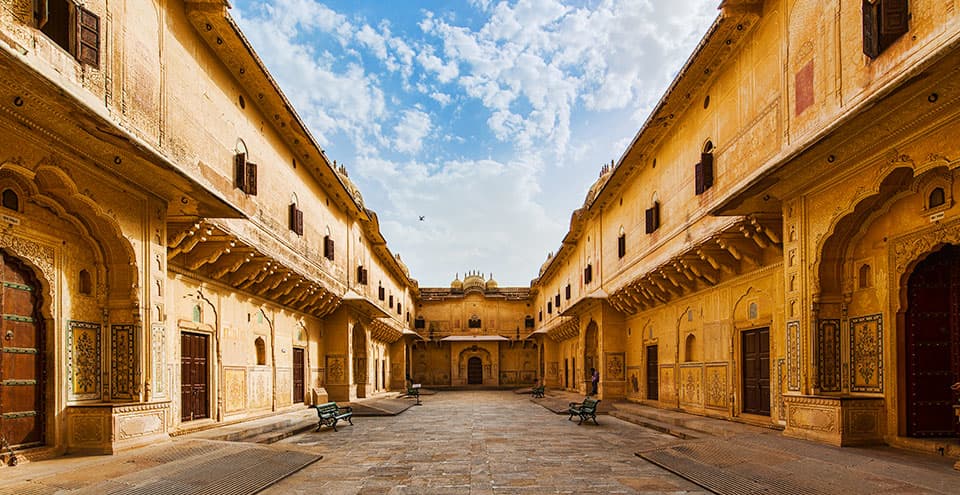 One of the most popular tourist destinations in Jaipur, the Madhvendra Palace was built by Sawai Ram Singh for his nine queens. This double storied palace has nine apartments that are beautifully decorated with flower motifs and mesmerizing murals which elevate the spacious courtyard. Around 15 km from Jaipur city and at a height of 700 feet, this palace probably has the most splendid views of them all. The nine apartments of the queen surround three sides of the palace, while the fourth houses the Maharaja’s living room. With its magnificent views, awe-inspiring wall paintings, and the chance to peek into the heritage and culture of Rajasthan, the Madhvendra Palace more than lives up to its popularity.
One of the most popular tourist destinations in Jaipur, the Madhvendra Palace was built by Sawai Ram Singh for his nine queens. This double storied palace has nine apartments that are beautifully decorated with flower motifs and mesmerizing murals which elevate the spacious courtyard. Around 15 km from Jaipur city and at a height of 700 feet, this palace probably has the most splendid views of them all. The nine apartments of the queen surround three sides of the palace, while the fourth houses the Maharaja’s living room. With its magnificent views, awe-inspiring wall paintings, and the chance to peek into the heritage and culture of Rajasthan, the Madhvendra Palace more than lives up to its popularity.
JAGAT SHIROMANI TEMPLE
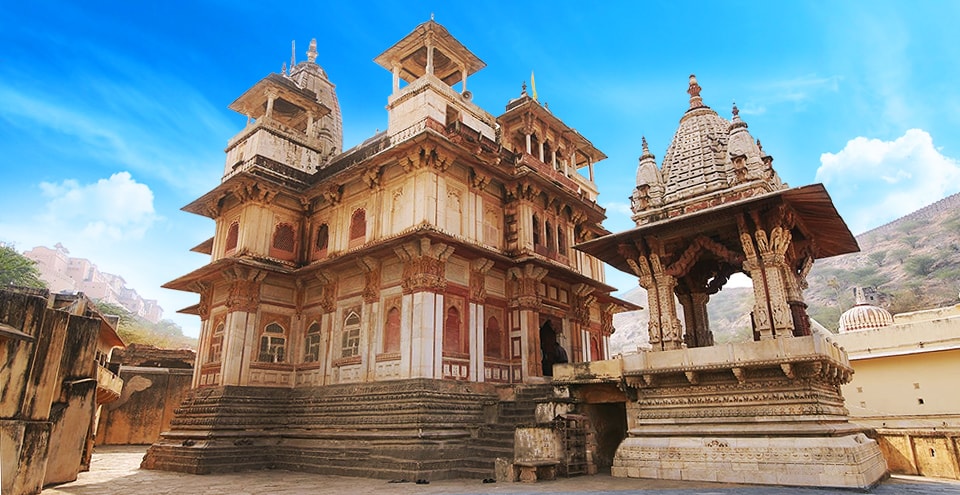 The Jagat Shiromani Temple is a Hindu temple located in Amer, Jaipur. Possessing an extraordinary architecture which enchants with its greatness and beauty, it is a site of immense fascination for the tourists. The temple is devoted to Hindu gods Lord Krishna and Lord Vishnu, and is said to be built around 1599-1608 AD by Queen Kanakwati, the wife of King Man Singh I, in the memory of their son Jagat Singh. ‘Jagat Shiromani’, meaning ‘Head Jewel of Lord Vishnu’, is an epochal facet of the ancient history of Rajasthan. The temple houses the idols of Lord Krishna, Lord Vishnu and Meera Bai. If we were to go by archaic religious texts, the idols within the temple are actually the ones that Meera Bai, the Hindu mystic poet and devotee of Krishna, worshipped in the State of Mewar. The Temple’s architecture is quite interesting – it is a riveting amalgamation of various architectural styles including Jain, Hindu, Mughal and South Indian. Carved out of white marble and black stone, the walls and ceilings of the temple are covered in exquisite bas relief carvings of elephants, horses, Purans and other legends. The most prodigious feature of the temple is the marble Torans (pylon) or ornamental arches at the entrance, carved out of a single piece of marble.
The Jagat Shiromani Temple is a Hindu temple located in Amer, Jaipur. Possessing an extraordinary architecture which enchants with its greatness and beauty, it is a site of immense fascination for the tourists. The temple is devoted to Hindu gods Lord Krishna and Lord Vishnu, and is said to be built around 1599-1608 AD by Queen Kanakwati, the wife of King Man Singh I, in the memory of their son Jagat Singh. ‘Jagat Shiromani’, meaning ‘Head Jewel of Lord Vishnu’, is an epochal facet of the ancient history of Rajasthan. The temple houses the idols of Lord Krishna, Lord Vishnu and Meera Bai. If we were to go by archaic religious texts, the idols within the temple are actually the ones that Meera Bai, the Hindu mystic poet and devotee of Krishna, worshipped in the State of Mewar. The Temple’s architecture is quite interesting – it is a riveting amalgamation of various architectural styles including Jain, Hindu, Mughal and South Indian. Carved out of white marble and black stone, the walls and ceilings of the temple are covered in exquisite bas relief carvings of elephants, horses, Purans and other legends. The most prodigious feature of the temple is the marble Torans (pylon) or ornamental arches at the entrance, carved out of a single piece of marble.
JAWAHAR CIRCLE
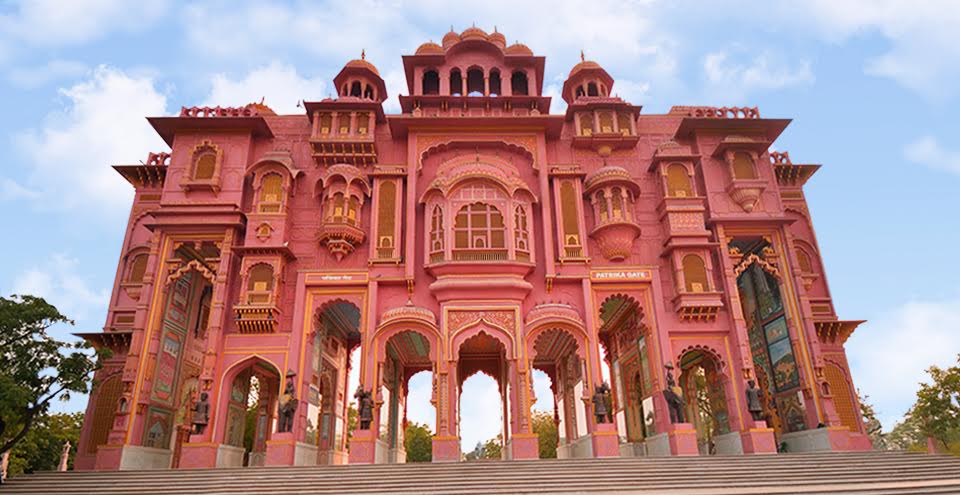 Located near the Jawaharlal Nehru Marg in the Pink City, Jaipur, the Jawahar Circle is a unique destination for all kinds of visitors. Honored as the largest circular park in Asia, Jawahar Circle is encompassed by a rose garden and offers a number of concentric jogging tracks, benches, and lush greenery.While the beautifully landscaped plantations and green areas of the park are enough to leave a visitor awed, the main attraction of the park has definitely got to be the Musical Fountain. The fountain creates spectacular shows with over 270 types of effects and over 300 colorful lights. Sometimes, the height of the water of the musical fountain reaches up to 25 feet as well. While Jawahar Circle is a delight to be in to spend a day relaxing amidst nature, it gets even better in the evening hours. Artfully lit up, the musical fountain show is a 30-minute treat that begins at 7 in the evening, and is something that simply cannot be missed.
Located near the Jawaharlal Nehru Marg in the Pink City, Jaipur, the Jawahar Circle is a unique destination for all kinds of visitors. Honored as the largest circular park in Asia, Jawahar Circle is encompassed by a rose garden and offers a number of concentric jogging tracks, benches, and lush greenery.While the beautifully landscaped plantations and green areas of the park are enough to leave a visitor awed, the main attraction of the park has definitely got to be the Musical Fountain. The fountain creates spectacular shows with over 270 types of effects and over 300 colorful lights. Sometimes, the height of the water of the musical fountain reaches up to 25 feet as well. While Jawahar Circle is a delight to be in to spend a day relaxing amidst nature, it gets even better in the evening hours. Artfully lit up, the musical fountain show is a 30-minute treat that begins at 7 in the evening, and is something that simply cannot be missed.
GAITORE (MEMORIALS OF KINGS)
 Just off the Jaipur-Amber road is Gaitore, where the former Maharajas of Jaipur are entombed. The chhatris (cenotaphs), made of white marble display the distinctive Rajput style of architecture. The open pavilions with ornate domes are supported by delicately sculpted pillars. The crematorium is located in the middle of yellow sandstone hills. The décor and extravagance of a particular chattri is meant to reflect the stature and prowess of the ruler it contains. The most graceful and beautiful chattri at Gaitor is that of Maharaja Jai Singh with 20 carved pillars. Tourists are especially drawn towards it because of its intricate carvings.
Just off the Jaipur-Amber road is Gaitore, where the former Maharajas of Jaipur are entombed. The chhatris (cenotaphs), made of white marble display the distinctive Rajput style of architecture. The open pavilions with ornate domes are supported by delicately sculpted pillars. The crematorium is located in the middle of yellow sandstone hills. The décor and extravagance of a particular chattri is meant to reflect the stature and prowess of the ruler it contains. The most graceful and beautiful chattri at Gaitor is that of Maharaja Jai Singh with 20 carved pillars. Tourists are especially drawn towards it because of its intricate carvings.
VIDYADHAR GARDEN
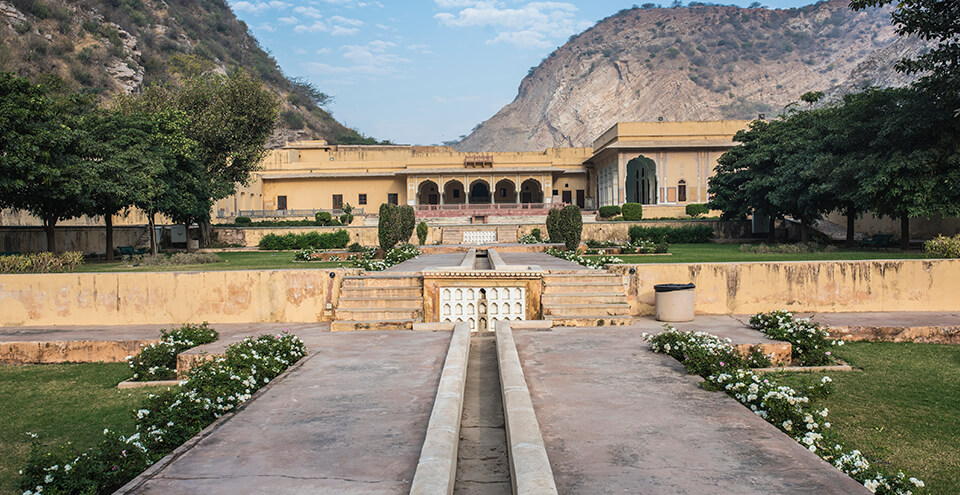 Located near Sisodia Garden, this is yet another beautiful garden which is a must-see for visitors. It is named after Vidyadhar Bhattacharya, the Chief Architect of Jaipur.
Located near Sisodia Garden, this is yet another beautiful garden which is a must-see for visitors. It is named after Vidyadhar Bhattacharya, the Chief Architect of Jaipur.
CENTRAL PARK
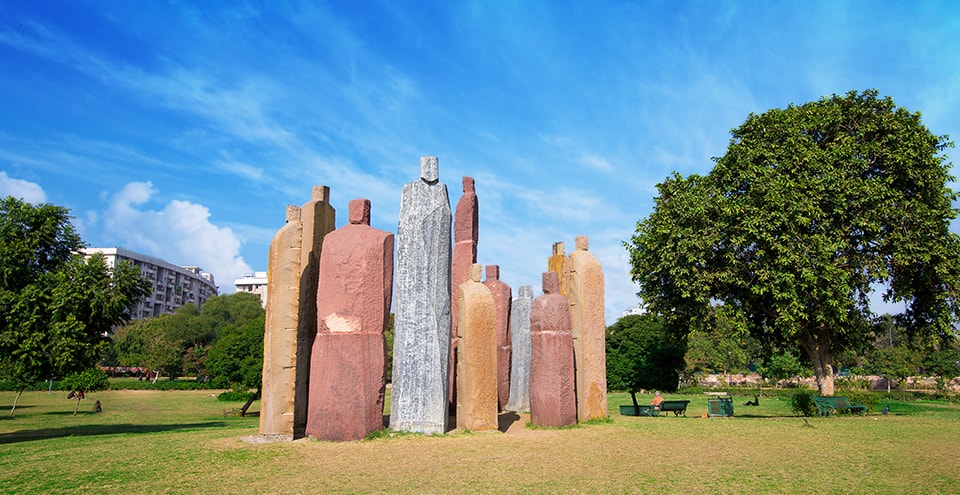 Central Park is a large green zone right in the centre of Jaipur that offers city dwellers a spot for a moment of respite. Conceptualized and built by the Jaipur Development Authority, it is Jaipur’s largest park. It houses a lush garden, the Polo Ground and a golf club. However, the highlight of the park is India’s first all-day-and-all-night monumental National Flag which also happens to be the country’s tallest flagpole.
Central Park is a large green zone right in the centre of Jaipur that offers city dwellers a spot for a moment of respite. Conceptualized and built by the Jaipur Development Authority, it is Jaipur’s largest park. It houses a lush garden, the Polo Ground and a golf club. However, the highlight of the park is India’s first all-day-and-all-night monumental National Flag which also happens to be the country’s tallest flagpole.
ANOKHI MUSEUM OF HAND PRINTING
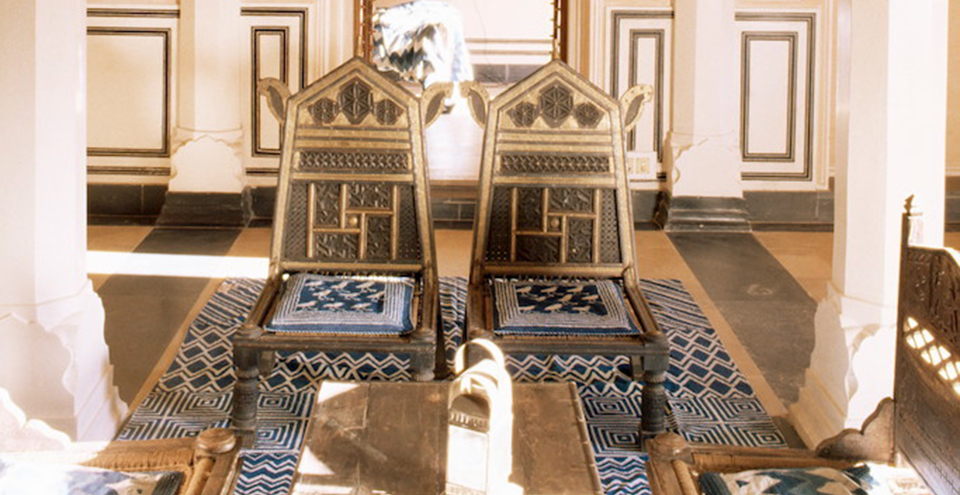 At a mere ten-minute walk through the cobbled streets of Amber lies the Anokhi Museum of Hand Printing. Located in a magnificently restored haveli (mansion), the museum displays a varied selection of block-printed textiles alongside images, tools and related objects – all chosen to provide an in-depth look into the complexity of this ancient tradition.
At a mere ten-minute walk through the cobbled streets of Amber lies the Anokhi Museum of Hand Printing. Located in a magnificently restored haveli (mansion), the museum displays a varied selection of block-printed textiles alongside images, tools and related objects – all chosen to provide an in-depth look into the complexity of this ancient tradition.
GOVIND DEVJI TEMPLE
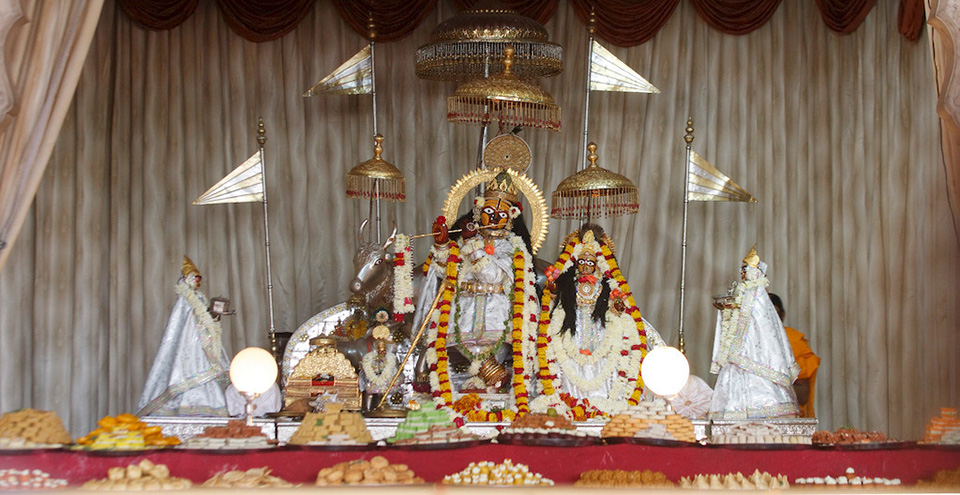
Heritage old temple of Govind Devji Lord Krishna ; Jaipur ; Rajasthan ; India
The Krishna temple is a rare spire-less temple and houses the idol of Govind Devji that Sawai Jai Singh brought from Vrindavan. The deity, worshipped by the erstwhile royal family, is also revered by the the locals in the area.
MOTI DOONGRI GANESH TEMPLE
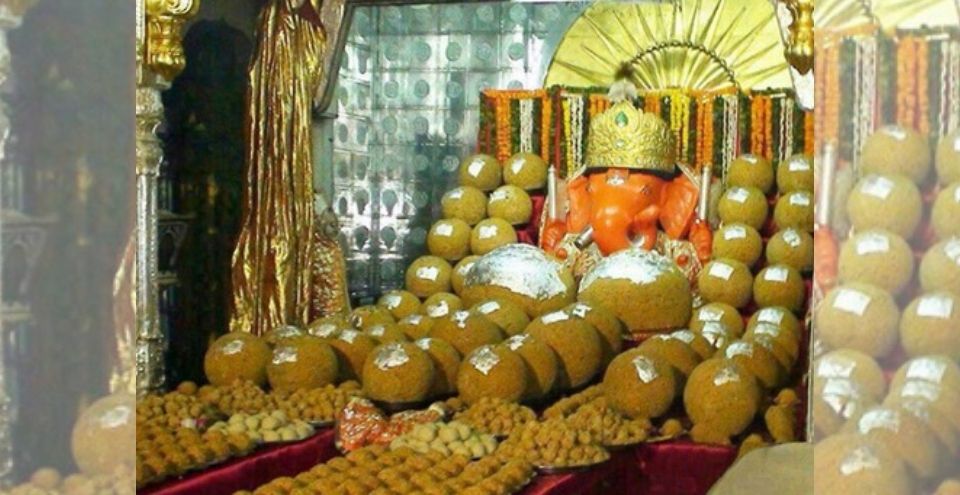 Moti Doongri is a small hill around which the city of Jaipur flourishes. Moti Doongri means pearl hill, because the hill indeed resembles a pearl drop. Visitors go there to pay homage at the famous Ganesh temple, the most auspicious and important religious temple in Jaipur. The Ganesh temple was built by Seth Jai Ram Paliwal, sometime in the early 18th century. A legend goes, the King of Mewar was heading back to his palace after a long journey and was carting a massive Ganesh idol on a bullock cart. The king had decided that he would build a temple for the idol of Lord Ganesh wherever the bullock cart stopped. Apparently the cart stopped at the foot of the Moti Doongri, which is where the temple is situated today. The hill also has an exotic palace perched right on top. A replica of a Scottish castle, it was once the royal home of Maharaja Sawai Man Singh. It continues to belong to the royal family. The mere view of this castle is extremely exotic.
Moti Doongri is a small hill around which the city of Jaipur flourishes. Moti Doongri means pearl hill, because the hill indeed resembles a pearl drop. Visitors go there to pay homage at the famous Ganesh temple, the most auspicious and important religious temple in Jaipur. The Ganesh temple was built by Seth Jai Ram Paliwal, sometime in the early 18th century. A legend goes, the King of Mewar was heading back to his palace after a long journey and was carting a massive Ganesh idol on a bullock cart. The king had decided that he would build a temple for the idol of Lord Ganesh wherever the bullock cart stopped. Apparently the cart stopped at the foot of the Moti Doongri, which is where the temple is situated today. The hill also has an exotic palace perched right on top. A replica of a Scottish castle, it was once the royal home of Maharaja Sawai Man Singh. It continues to belong to the royal family. The mere view of this castle is extremely exotic.
DIGAMBER JAIN MANDIR
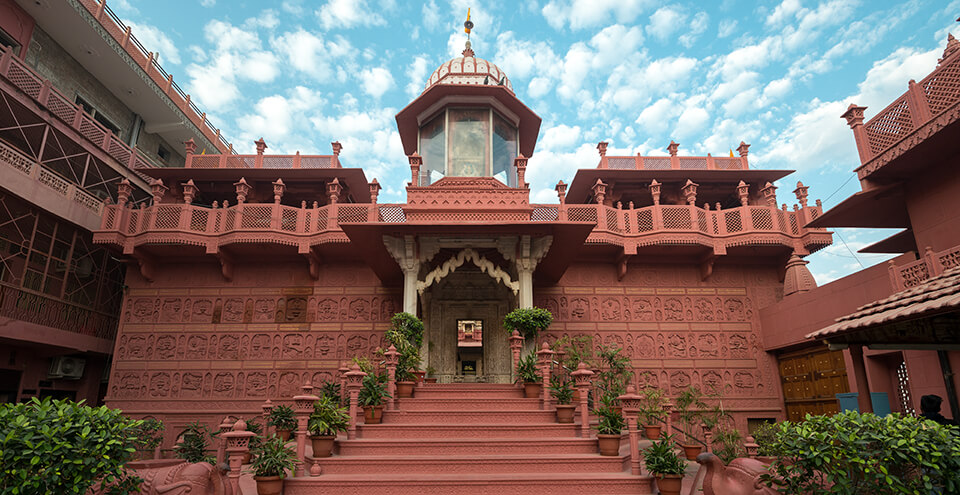 The ancient Digamber Jain temple at Jaipur is in Sanganer, 14 km from the city. The principal idol in the Sanghiji Temple is of Lord Adinath in the Padmasan (lotus position) posture. The temple is made of red stone and has attractive carvings. The seven-storied temple has sky-high ‘shikharas’ (spires) and its inner sanctum is a stone shrine with eight sky-high shikharas.
The ancient Digamber Jain temple at Jaipur is in Sanganer, 14 km from the city. The principal idol in the Sanghiji Temple is of Lord Adinath in the Padmasan (lotus position) posture. The temple is made of red stone and has attractive carvings. The seven-storied temple has sky-high ‘shikharas’ (spires) and its inner sanctum is a stone shrine with eight sky-high shikharas.
STATUE CIRCLE
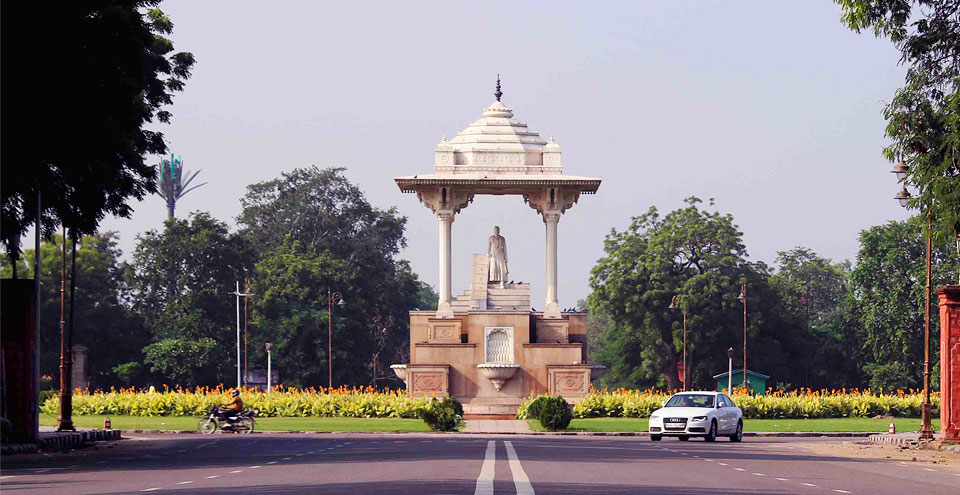 A life-size white marble statue of Sawai Jai Singh II, the founder of Jaipur, stands tall in the middle of a circle in the C-Scheme area. Erected in his honour, the statue pays homage to the founder of Jaipur.
A life-size white marble statue of Sawai Jai Singh II, the founder of Jaipur, stands tall in the middle of a circle in the C-Scheme area. Erected in his honour, the statue pays homage to the founder of Jaipur.
RAM NIWAS GARDEN
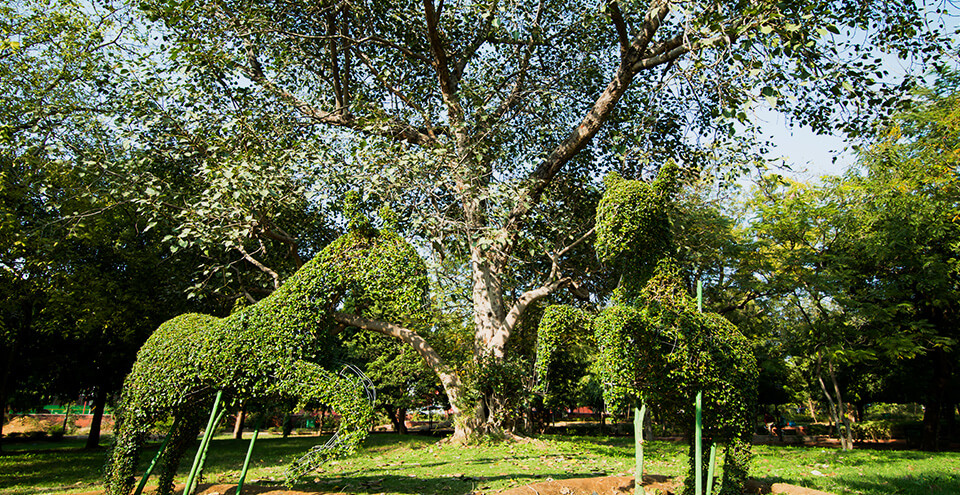 This historical garden was built by Maharaja Sawai Ram Singh in 1868. Located in the heart of the city, the garden houses the Albert Hall Museum (now known as Central Museum), a bird park, a zoo, the Ravindra Rang Manch theatre, an art gallery and an exhibition ground.
This historical garden was built by Maharaja Sawai Ram Singh in 1868. Located in the heart of the city, the garden houses the Albert Hall Museum (now known as Central Museum), a bird park, a zoo, the Ravindra Rang Manch theatre, an art gallery and an exhibition ground.
RAJ MANDIR
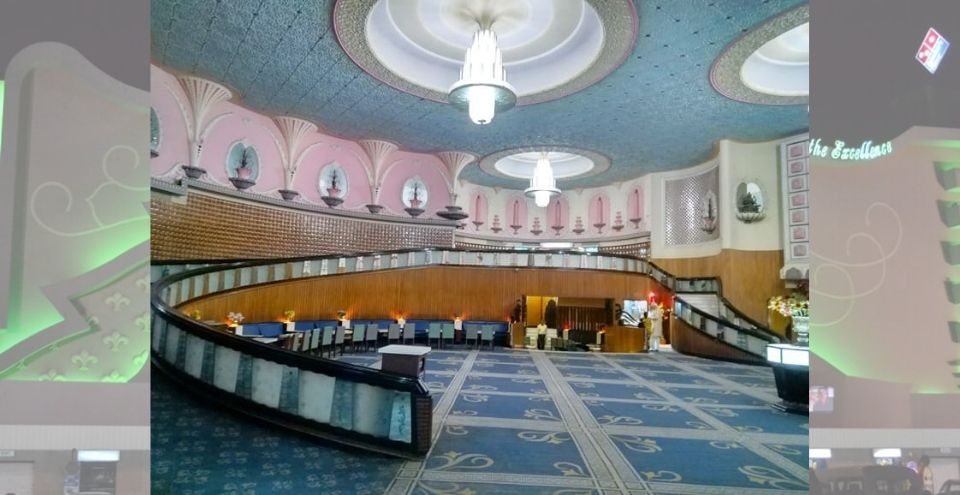 One of the most famous spots in Jaipur is the Raj Mandir Cinema. A single-screen experience, done up with a royal and luxurious architecture, the cinema holds a special place in the Pink City. Watching a Hindi movie is an amazing experience at this cinema, and booking your seat in advance is always a good idea. It was established in 1976. An asymmetrical exterior design helps the theater stand apart. Inside, the extravagantly finished roof, grand chandeliers, and a rising staircase next to the lobby lend an old world charm to the place.Located just off MI road, a Jaipur trip cannot be considered complete without a visit to the Raj Mandir.
One of the most famous spots in Jaipur is the Raj Mandir Cinema. A single-screen experience, done up with a royal and luxurious architecture, the cinema holds a special place in the Pink City. Watching a Hindi movie is an amazing experience at this cinema, and booking your seat in advance is always a good idea. It was established in 1976. An asymmetrical exterior design helps the theater stand apart. Inside, the extravagantly finished roof, grand chandeliers, and a rising staircase next to the lobby lend an old world charm to the place.Located just off MI road, a Jaipur trip cannot be considered complete without a visit to the Raj Mandir.
ZOOLOGICAL GARDEN
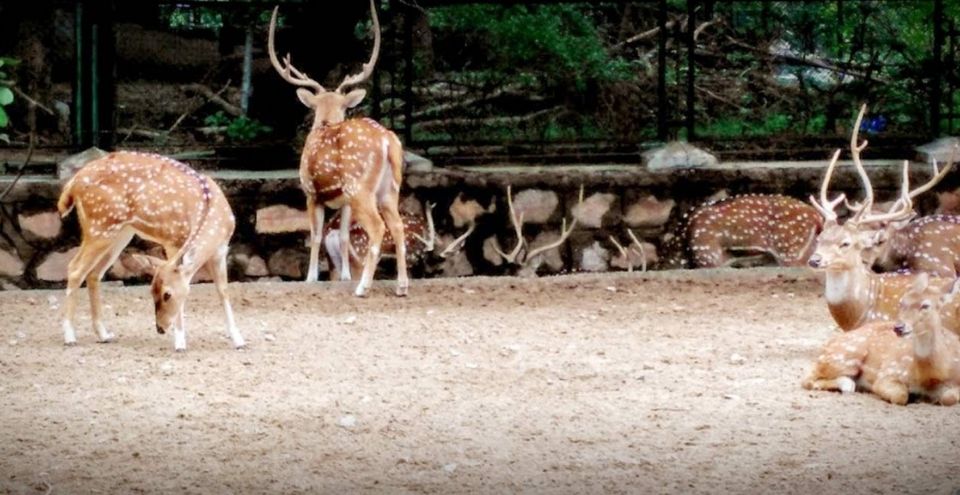 The Zoological Garden or Jaipur Zoo was founded by Sawai Raja Pratap Singh in the year 1868. It is located in Ram Niwas Bagh, within walking distance of the famous Albert Hall.
The Zoological Garden or Jaipur Zoo was founded by Sawai Raja Pratap Singh in the year 1868. It is located in Ram Niwas Bagh, within walking distance of the famous Albert Hall.
KANAK VRINDAVAN
 Located at the foothills of Nahargarh hills on the way to Amber, Kanak Vrindavan is popular among the locals for picnics. The beautifully landscaped garden houses an intricately carved temple, several terrace sites, marble columns and lattices, making it a dream location for film shoots as well.
Located at the foothills of Nahargarh hills on the way to Amber, Kanak Vrindavan is popular among the locals for picnics. The beautifully landscaped garden houses an intricately carved temple, several terrace sites, marble columns and lattices, making it a dream location for film shoots as well.
ISHWAR LAT (SWARGASULI)
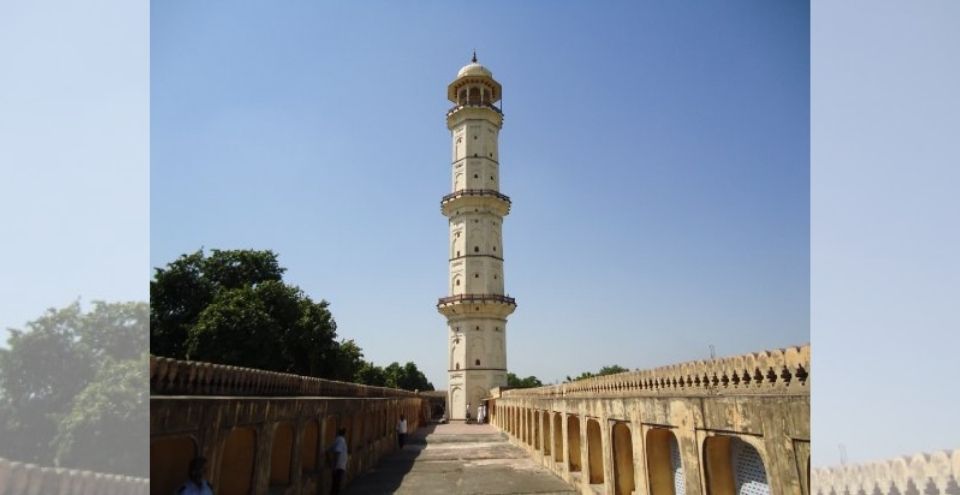 Ishwar Lat, is a 60 feet high grand minaret in Jaipur. Also called ‘Swarg Suli’ or ‘heaven piercing minaret’, this tower near Tripolia Gate was built by Raja Ishwari Singh in 1749 A.D to commemorate a grand victory. Ishwar Lat offers a breath-taking view of Jaipur.
Ishwar Lat, is a 60 feet high grand minaret in Jaipur. Also called ‘Swarg Suli’ or ‘heaven piercing minaret’, this tower near Tripolia Gate was built by Raja Ishwari Singh in 1749 A.D to commemorate a grand victory. Ishwar Lat offers a breath-taking view of Jaipur.
AMAR JAWAN JYOTI
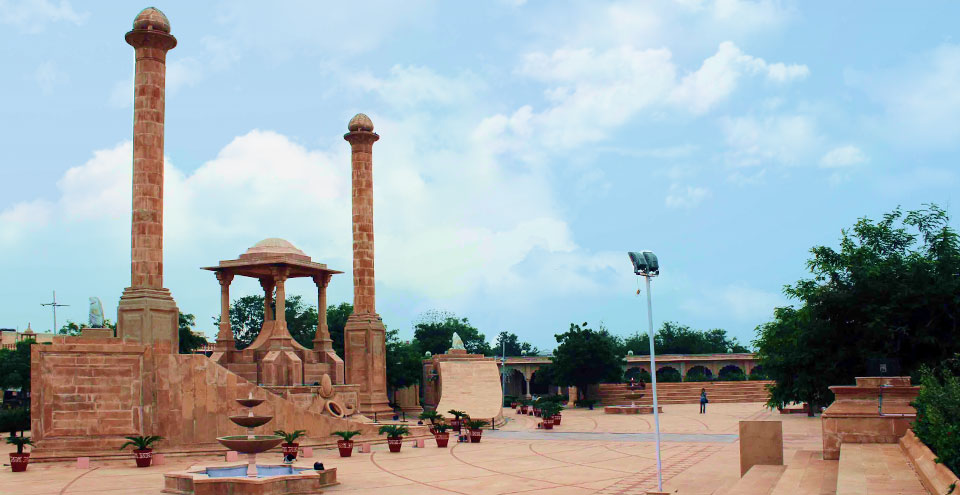 The Amar Jawan Jyoti, or the ‘flame of the immortal soldiers’, is a memorial dedicated to the martyrs of Rajasthan. This memorial is situated near Jaipur’s Vidhan Sabha Bhawan (Legislative Assembly).The key attraction of the Amar Jawan Jyoti is that the torches at the four corners of the structure are always burning. In evenings, this formidable structure is attractively lit up in vivid colours. The brilliant lighting effects make this a picturesque spot a favourite with tourists.
The Amar Jawan Jyoti, or the ‘flame of the immortal soldiers’, is a memorial dedicated to the martyrs of Rajasthan. This memorial is situated near Jaipur’s Vidhan Sabha Bhawan (Legislative Assembly).The key attraction of the Amar Jawan Jyoti is that the torches at the four corners of the structure are always burning. In evenings, this formidable structure is attractively lit up in vivid colours. The brilliant lighting effects make this a picturesque spot a favourite with tourists.
MAHARANI KI CHHATRI (MEMORIALS OF QUEENS)
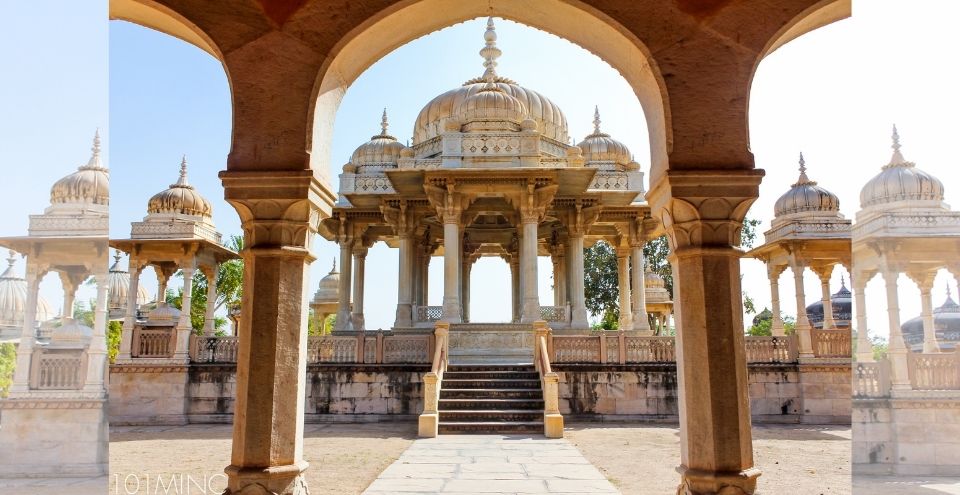 Maharani Ki Chhatri was a special funeral area for women belonging to Jaipur’s royal family and is located on the way to Amber fort. This crematorium has several exquisitely carved cenotaphs built to commemorate them. The cenotaphs are either built with marble or the local stones. As a popular belief, a cenotaph was finished with a roof structure only if the queen died before her king. In case she died after the king, it would remain unfinished. One of the significant features of these cenotaphs is the use of chhatri (umbrella), a quintessential architectural style of the Rajputs.
Maharani Ki Chhatri was a special funeral area for women belonging to Jaipur’s royal family and is located on the way to Amber fort. This crematorium has several exquisitely carved cenotaphs built to commemorate them. The cenotaphs are either built with marble or the local stones. As a popular belief, a cenotaph was finished with a roof structure only if the queen died before her king. In case she died after the king, it would remain unfinished. One of the significant features of these cenotaphs is the use of chhatri (umbrella), a quintessential architectural style of the Rajputs.
NAHARGARH BIOLOGICAL PARK
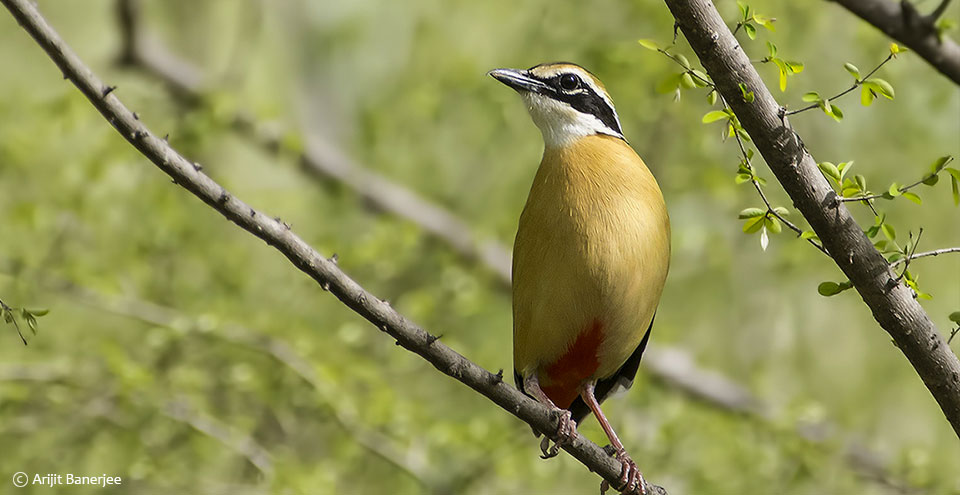 Nahargarh Biological Park, a part of the Nahargarh sanctuary is located about 12 km from Jaipur on the Jaipur-Delhi highway. It encompasses a large area of 720 hectares and is situated under the Aravalli range. The Park is famous for its vast flora and fauna, and its main aim is to conserve it. It also doubles up as a great place to educate people and conduct research on existing flora and fauna. At Nahargarh Biological Park, ornithologists can expect to see over 285 species of birds, of which, the most popular is the white-naped tit, which can only be found here. When you visit the Park, make sure you also head to Ram Sagar, which is a famous among bird watchers and makes for a great spot to catch different varieties of birds. While here, you can stay at well-equipped and famous places such as Ganga Vilas, Gopal Vilas and Lalit Vilas, which were famous with the maharajas of the yore as hunting lodges. The Nahargarh Zoological Park is also worth a visit and houses animals such as Asiatic lions, Bengal tigers, panthers, hyenas, wolves, deer, crocodiles, sloth bear, Himalayan black bear, wild boar, etc. The zoo is open from 15th March – 14th October between 8.30 am to 5.30 pm and from 15th October – 14th March between 9.00 am to 5.00 pm. It is closed on Tuesdays so make sure you plan your visit accordingly. Ticket Cost- Indian visitors: 50/- per person| Foreigner: 300/- per person| Student: 20/- per student| Car/jeep: 300/- per vehicle| Motor cycle: 30/- per vehicle| Auto rickshaw: 60/- per vehicle| Bus: 500/- per vehicle| Camera (Indian): 200/- | Camera (Foreigner): 400/- | Video Camera (Indian): 500/- | Video Camera (Foreigner): 1000/-.
Nahargarh Biological Park, a part of the Nahargarh sanctuary is located about 12 km from Jaipur on the Jaipur-Delhi highway. It encompasses a large area of 720 hectares and is situated under the Aravalli range. The Park is famous for its vast flora and fauna, and its main aim is to conserve it. It also doubles up as a great place to educate people and conduct research on existing flora and fauna. At Nahargarh Biological Park, ornithologists can expect to see over 285 species of birds, of which, the most popular is the white-naped tit, which can only be found here. When you visit the Park, make sure you also head to Ram Sagar, which is a famous among bird watchers and makes for a great spot to catch different varieties of birds. While here, you can stay at well-equipped and famous places such as Ganga Vilas, Gopal Vilas and Lalit Vilas, which were famous with the maharajas of the yore as hunting lodges. The Nahargarh Zoological Park is also worth a visit and houses animals such as Asiatic lions, Bengal tigers, panthers, hyenas, wolves, deer, crocodiles, sloth bear, Himalayan black bear, wild boar, etc. The zoo is open from 15th March – 14th October between 8.30 am to 5.30 pm and from 15th October – 14th March between 9.00 am to 5.00 pm. It is closed on Tuesdays so make sure you plan your visit accordingly. Ticket Cost- Indian visitors: 50/- per person| Foreigner: 300/- per person| Student: 20/- per student| Car/jeep: 300/- per vehicle| Motor cycle: 30/- per vehicle| Auto rickshaw: 60/- per vehicle| Bus: 500/- per vehicle| Camera (Indian): 200/- | Camera (Foreigner): 400/- | Video Camera (Indian): 500/- | Video Camera (Foreigner): 1000/-.
JAIPUR WAX MUSEUM
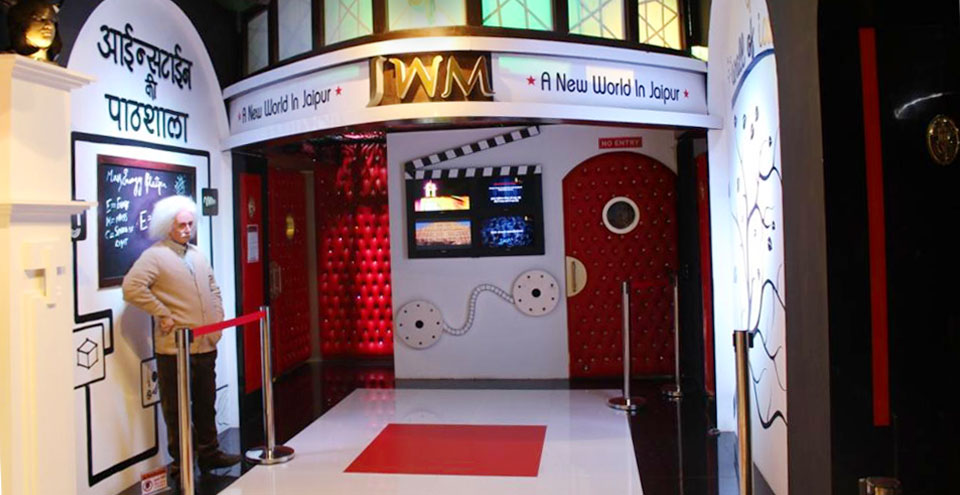 Amidst the confines of the Nahargarh Fort at the foothills of the Aravallis lies the Jaipur wax museum, a visit of which is sure to leave you awe-struck! It has been developed by Entertainment 7 Ventures Pvt Ltd. Hosting over 30 wax statues of famed personalities, the museum is a spectacle to behold! The wax museum, as the name suggests, holds wax statues of many leading personalities such as Amitabh Bachchan, Mahatma Gandhi, Bhagat Singh, Rabindranath Tagore, Albert Einstein, Michael Jackson, Sawai Jai Singh II, Maharani Gayatri Devi and many Indian and International leads. The life-like replicas along with detailed backdrops and ingenious sets provide an overwhelming yet unique experience. The museum also has a display of the 10 foot long Bullet, Gati Gamini, the signature Rajasthan Tourism Motorbike. The timing for the wax museum and sheesh Mahal is from 10 am to 6.30 pm and open all days of the week, The ticket price per person for wax museum and Sheesh Mahal is Rs 500 for Indians, and Combo entry for International Travellers is Rs 700 for all days.
Amidst the confines of the Nahargarh Fort at the foothills of the Aravallis lies the Jaipur wax museum, a visit of which is sure to leave you awe-struck! It has been developed by Entertainment 7 Ventures Pvt Ltd. Hosting over 30 wax statues of famed personalities, the museum is a spectacle to behold! The wax museum, as the name suggests, holds wax statues of many leading personalities such as Amitabh Bachchan, Mahatma Gandhi, Bhagat Singh, Rabindranath Tagore, Albert Einstein, Michael Jackson, Sawai Jai Singh II, Maharani Gayatri Devi and many Indian and International leads. The life-like replicas along with detailed backdrops and ingenious sets provide an overwhelming yet unique experience. The museum also has a display of the 10 foot long Bullet, Gati Gamini, the signature Rajasthan Tourism Motorbike. The timing for the wax museum and sheesh Mahal is from 10 am to 6.30 pm and open all days of the week, The ticket price per person for wax museum and Sheesh Mahal is Rs 500 for Indians, and Combo entry for International Travellers is Rs 700 for all days.
SAMBHAR LAKE
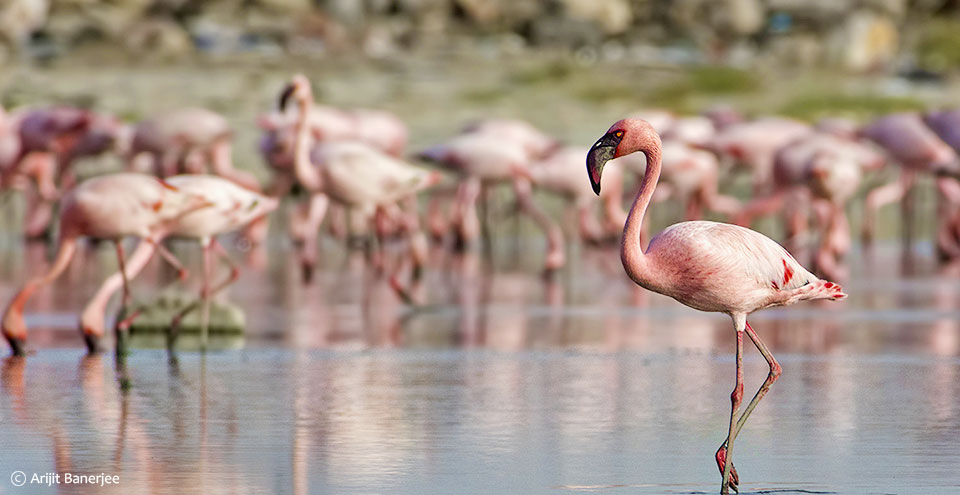 Sambhar Lake is one of the largest inland salt lake and lies just 70 kms from Jaipur. It is an incredible landscape, almost resembling the Rann of Kutch, Gujarat. Apart from producing a large percentage of India’s salt supply – it also an incredible place to spot birds including large flocks of flamingos. The views from the Shakambhari Mata Temple are breathtaking at sunset and one can spend hours in solitude. Another unique aspect is the Saltwork’s own railway system built to transfer salt from the pans to the processing unit. A visit to the salt lake and a walk in the Sambhar town is also a must do activity. Devyani Kund, Sharmishtha Sarovar, Salt Museum, Circuit House, etc are also important places to visit in Sambhar. One can also visit religious sites Naraina & Bhairana on the way to Sambhar.
Sambhar Lake is one of the largest inland salt lake and lies just 70 kms from Jaipur. It is an incredible landscape, almost resembling the Rann of Kutch, Gujarat. Apart from producing a large percentage of India’s salt supply – it also an incredible place to spot birds including large flocks of flamingos. The views from the Shakambhari Mata Temple are breathtaking at sunset and one can spend hours in solitude. Another unique aspect is the Saltwork’s own railway system built to transfer salt from the pans to the processing unit. A visit to the salt lake and a walk in the Sambhar town is also a must do activity. Devyani Kund, Sharmishtha Sarovar, Salt Museum, Circuit House, etc are also important places to visit in Sambhar. One can also visit religious sites Naraina & Bhairana on the way to Sambhar.
AKSHARDHAM TEMPLE
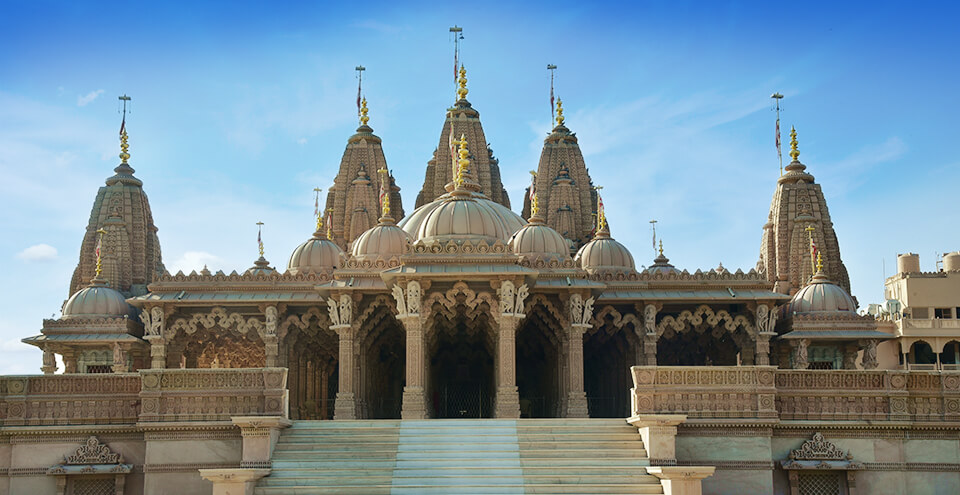 One of the most-visited temples in the city of Jaipur, the Akshardham Temple depicts real architectural wonders. Surrounded by lush green gardens and charming fountains, the Akshardham Temple has unique architectural features, including the walls which are covered with a number of carvings and sculptures that are beautiful to look at. This helps create an amazing atmosphere of peace and serenity, attracting not just thousands of devotees, but also a number of tourists throughout the year. The temple is located in Vaishali Nagar in Jaipur, and is devoted to the Hindu God, Narayan, whose beautiful statue is covered in silver and gold ornaments. The temple very religiously reflects the rich culture, unique heritage, and royal history of Rajasthan, enrapturing its visitors with its beautiful architecture, paintings, and mantras. It also offers visitors beautiful views and a chance to discover a lot more about the religion.
One of the most-visited temples in the city of Jaipur, the Akshardham Temple depicts real architectural wonders. Surrounded by lush green gardens and charming fountains, the Akshardham Temple has unique architectural features, including the walls which are covered with a number of carvings and sculptures that are beautiful to look at. This helps create an amazing atmosphere of peace and serenity, attracting not just thousands of devotees, but also a number of tourists throughout the year. The temple is located in Vaishali Nagar in Jaipur, and is devoted to the Hindu God, Narayan, whose beautiful statue is covered in silver and gold ornaments. The temple very religiously reflects the rich culture, unique heritage, and royal history of Rajasthan, enrapturing its visitors with its beautiful architecture, paintings, and mantras. It also offers visitors beautiful views and a chance to discover a lot more about the religion.
SCULPTURE PARK (NAHARGARH)
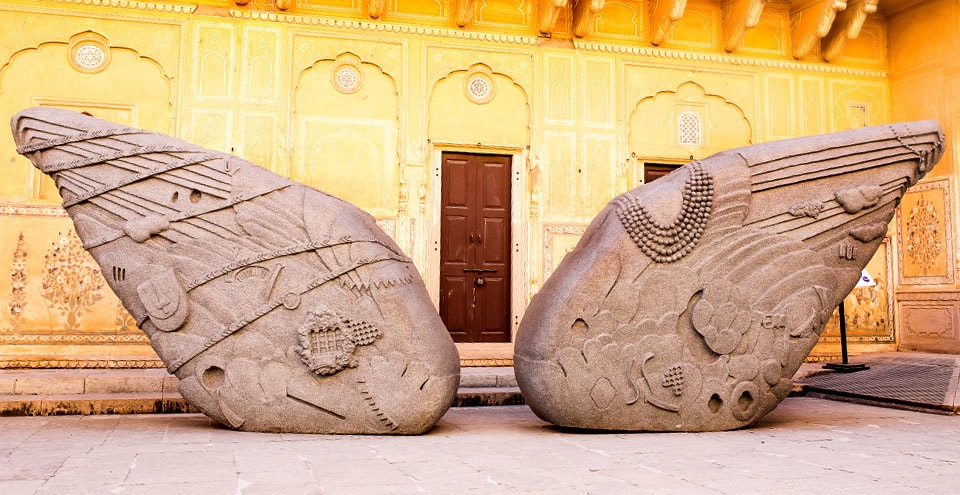 Perched on the edge of the Aravallis, the NahargarhFort, overlooking the city of Jaipur, has always been a popular tourist destination. Now, adding zing to the already colorful history of the fort, under an initiative by the Government of Rajasthan, the Fort also houses the Sculpture Park. This is a one-of-a-kind venue that showcases works of contemporary arts. This project is a collaborative effort by the Government of Rajasthan and SathSaath Arts, which is a non-profit NGO. It aims to turn the palace into a gallery for contemporary art, with sculptures by top Indian and international artists being displayed indoors and outdoors. The Sculpture Park at Nahargarh Fort is an initiative that aims to promote the country’s ever growing interest in contemporary art, while at the same timeembracing the heritage of India.This gallery is open to the public, and is the perfectcoming together of India’s distinctive past and present.
Perched on the edge of the Aravallis, the NahargarhFort, overlooking the city of Jaipur, has always been a popular tourist destination. Now, adding zing to the already colorful history of the fort, under an initiative by the Government of Rajasthan, the Fort also houses the Sculpture Park. This is a one-of-a-kind venue that showcases works of contemporary arts. This project is a collaborative effort by the Government of Rajasthan and SathSaath Arts, which is a non-profit NGO. It aims to turn the palace into a gallery for contemporary art, with sculptures by top Indian and international artists being displayed indoors and outdoors. The Sculpture Park at Nahargarh Fort is an initiative that aims to promote the country’s ever growing interest in contemporary art, while at the same timeembracing the heritage of India.This gallery is open to the public, and is the perfectcoming together of India’s distinctive past and present.
JHALANA SAFARI PARK IN JAIPUR
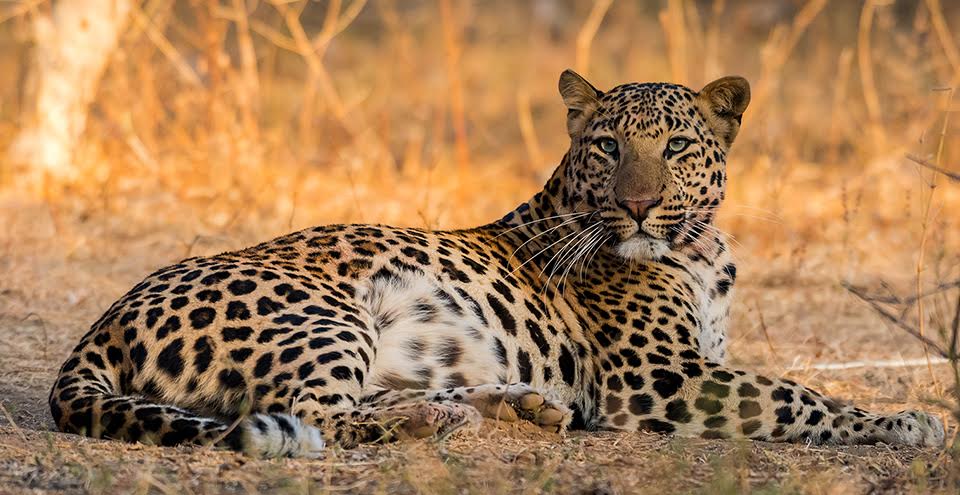 Jhalana Safari Park is an expansive and beautiful safari park in Jaipur that’s popular for its leopard sightings. The forest block has an area of 1978 hectare and is situated on south eastern border of Jaipur city. Until 1860, the park was under Feudalistic rule. It was the exclusive property of the erstwhile Jaipur estate and was basically used by the royals to play sports, and to meet the fuel and fodder needs of neighbouring villages. In 1862, Dr Brandis was appointed as the Inspector General of the forest to supervise the administration of the forest under a systematic management. The park is immensely rich in flora and fauna, and the vegetation here is categorized as northern tropical dry deciduous forest type. The safari tour here is raw, wild, and forthcoming, as the park lets the visitors witness wildlife in its natural habitat. Besides leopards, the safari also has around 15-20 panthers reigning the forest area. Other wildlife viewing opportunities at Jhalana Safari Park entail insightful excursions for discovering and exploring diverse wildlife, including striped hyenas, desert fox, golden jackal, chital, Indian palm civets, blue bulls, jungle cat, and many more. Besides this, the Jhalana Safari Park is a bird watcher’s paradise too, as it is home to various species of birds, including the Indian Pitta, Dusky Eagle, Owl, Spotted Owlet, Indian roller, sikra, and hawks, among others. With its expansive landscapes and diverse animal life, there are a few popular places of interest in the park as well; namely, a majestic shikar oudhi built in 1835 by Sawai Ram Singh, a big temple of Kali Mata, and a Jain Chulgiri Temple.
Jhalana Safari Park is an expansive and beautiful safari park in Jaipur that’s popular for its leopard sightings. The forest block has an area of 1978 hectare and is situated on south eastern border of Jaipur city. Until 1860, the park was under Feudalistic rule. It was the exclusive property of the erstwhile Jaipur estate and was basically used by the royals to play sports, and to meet the fuel and fodder needs of neighbouring villages. In 1862, Dr Brandis was appointed as the Inspector General of the forest to supervise the administration of the forest under a systematic management. The park is immensely rich in flora and fauna, and the vegetation here is categorized as northern tropical dry deciduous forest type. The safari tour here is raw, wild, and forthcoming, as the park lets the visitors witness wildlife in its natural habitat. Besides leopards, the safari also has around 15-20 panthers reigning the forest area. Other wildlife viewing opportunities at Jhalana Safari Park entail insightful excursions for discovering and exploring diverse wildlife, including striped hyenas, desert fox, golden jackal, chital, Indian palm civets, blue bulls, jungle cat, and many more. Besides this, the Jhalana Safari Park is a bird watcher’s paradise too, as it is home to various species of birds, including the Indian Pitta, Dusky Eagle, Owl, Spotted Owlet, Indian roller, sikra, and hawks, among others. With its expansive landscapes and diverse animal life, there are a few popular places of interest in the park as well; namely, a majestic shikar oudhi built in 1835 by Sawai Ram Singh, a big temple of Kali Mata, and a Jain Chulgiri Temple.
MASALA CHOWK
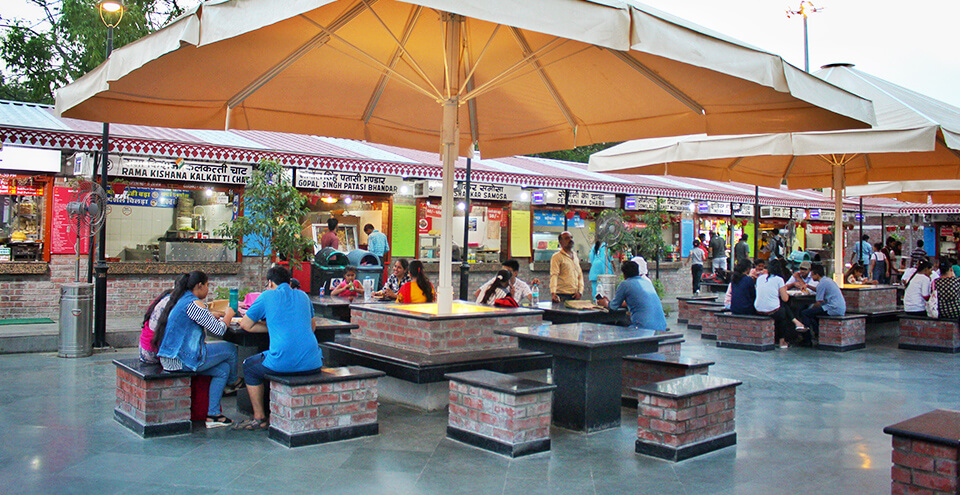 The nostalgia of the Kiran Café at Ram Niwas Bagh was hard to let go off. But now, the show is back on the road, with a new name – ‘Masala Chowk’, a place where you get to celebrate and indulge in the tastes of the street food of Jaipur.The place has become a rather popular hangout spot among visitors to the city. One can taste the best street foods of Jaipur at Masala Chowk and sit around enjoying the local flavours of the city. Masala Chowk is home to a total of 21 street food stalls, and charges an entry fee of Rs 10 to get in. The best time to visit is in the evening; that is when you also get the chance to mingle with the locals of the place.
The nostalgia of the Kiran Café at Ram Niwas Bagh was hard to let go off. But now, the show is back on the road, with a new name – ‘Masala Chowk’, a place where you get to celebrate and indulge in the tastes of the street food of Jaipur.The place has become a rather popular hangout spot among visitors to the city. One can taste the best street foods of Jaipur at Masala Chowk and sit around enjoying the local flavours of the city. Masala Chowk is home to a total of 21 street food stalls, and charges an entry fee of Rs 10 to get in. The best time to visit is in the evening; that is when you also get the chance to mingle with the locals of the place.
AMRAPALI MUSEUM
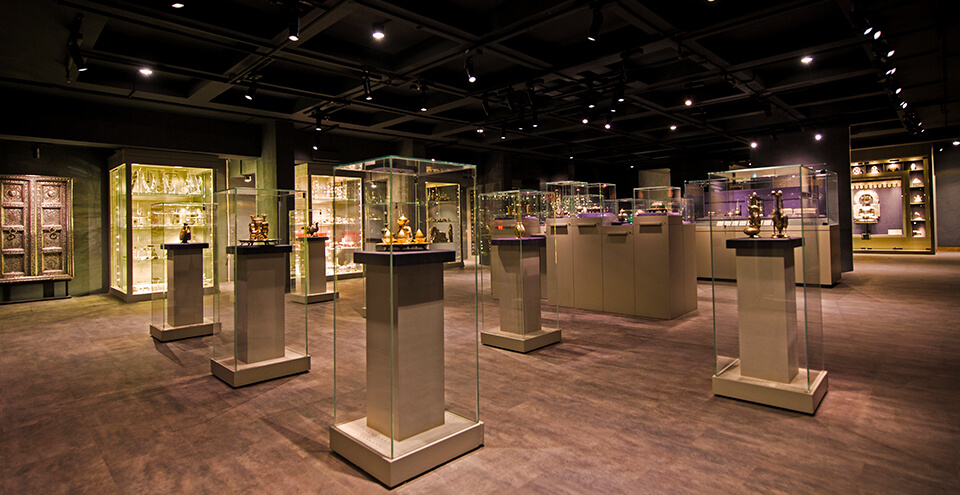 Amrapali Museum is an initiative by the founders of Amrapali Jewels Pvt. Ltd. The museum is dedicated to Indian jewellery and jewelled objects, located in the city of Jaipur. For the founders (Rajiv Arora and Rajesh Ajmera) the collection has been a labour of love that began nearly forty years ago when they became friends at college, and that continues to this day. The museum has several areas to focus over two floors. The ground floor displays items of beauty and adornment, silver and gold jewellery for every part of the body, from virtually every region of India; with a special focus on pieces that are connected with rites of passage, from birth to death. The basement houses numerous inspirations for designs that have been available to the Indian craftsman over time, seen through both the jewelry and the range of silver objects in the collection. A separate section is dedicated to heirloom textiles that are embellished with gold and silver. The entire collection is made up of over 4000 pieces, of which around 800 are on display. The rest can be seen in the Visual Storage. Unlike other museums, where thousands of exhibits remain out of sight for lack of space, Amrapali Museum brings you the Visual Store, housing the reserve collection. Visitors are welcome to explore the Visual Store cases in the museum. The Founders are keen to share their entire collection with the world, in the belief that the unknown creators of each piece would have wanted their work to be seen and admired. Because these creations are ageless, timeless and priceless. Visitors from foreign shores will be entranced by this fascinating testimony to India’s craftsmanship. Jewellery for every part of the human form, jewelled artefacts from every corner of India, heirloom textiles embellished with gold and silver, and much more. Visitors can also shop handcrafted silver jewellery and objects similar to that of in the museum and also complete range of fine and silver jewellery from our Museum Shop. For more information visit- www.amrapalimuseum.com The opening hours are from 11.00 am to 6.00 pm from Monday to Saturday, The ticket price per person is Rs 600/- (Audio Guide Included)
Amrapali Museum is an initiative by the founders of Amrapali Jewels Pvt. Ltd. The museum is dedicated to Indian jewellery and jewelled objects, located in the city of Jaipur. For the founders (Rajiv Arora and Rajesh Ajmera) the collection has been a labour of love that began nearly forty years ago when they became friends at college, and that continues to this day. The museum has several areas to focus over two floors. The ground floor displays items of beauty and adornment, silver and gold jewellery for every part of the body, from virtually every region of India; with a special focus on pieces that are connected with rites of passage, from birth to death. The basement houses numerous inspirations for designs that have been available to the Indian craftsman over time, seen through both the jewelry and the range of silver objects in the collection. A separate section is dedicated to heirloom textiles that are embellished with gold and silver. The entire collection is made up of over 4000 pieces, of which around 800 are on display. The rest can be seen in the Visual Storage. Unlike other museums, where thousands of exhibits remain out of sight for lack of space, Amrapali Museum brings you the Visual Store, housing the reserve collection. Visitors are welcome to explore the Visual Store cases in the museum. The Founders are keen to share their entire collection with the world, in the belief that the unknown creators of each piece would have wanted their work to be seen and admired. Because these creations are ageless, timeless and priceless. Visitors from foreign shores will be entranced by this fascinating testimony to India’s craftsmanship. Jewellery for every part of the human form, jewelled artefacts from every corner of India, heirloom textiles embellished with gold and silver, and much more. Visitors can also shop handcrafted silver jewellery and objects similar to that of in the museum and also complete range of fine and silver jewellery from our Museum Shop. For more information visit- www.amrapalimuseum.com The opening hours are from 11.00 am to 6.00 pm from Monday to Saturday, The ticket price per person is Rs 600/- (Audio Guide Included)
MUSEUM OF GEM AND JEWELLERY
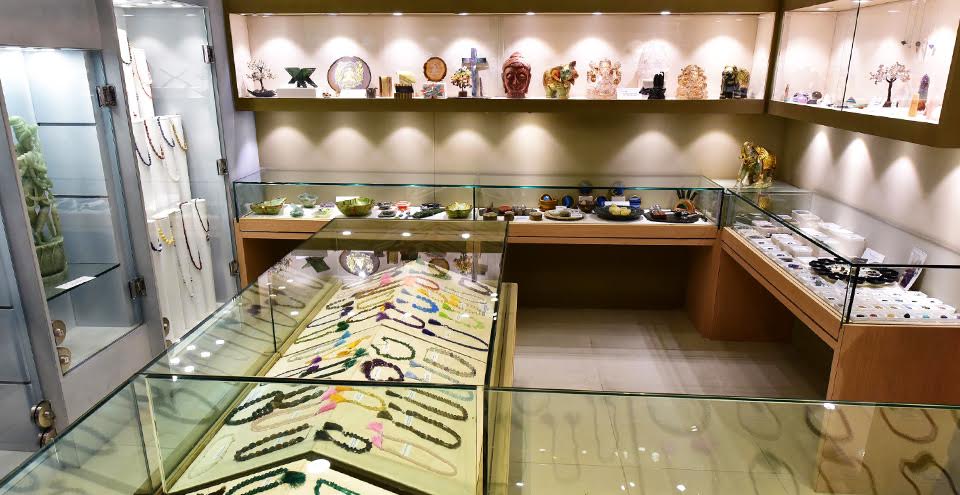 The pristine beauty of vibrant and colourful precious stones always fascinates,and taking this fascination to the next level with beautiful displays of the best in jewellery and gems, accompanied by their histories, is the Museum of Gem and Jewellery in Jaipur. Located in the heart of the city, in the Rajasthan Chambers building near New Gate, the museum tells stories about the rich legacy of the gem industry in Jaipur.From showcasing diverse specimens and their origins to taking you through the history of trade and displaying exquisite craftsmanship, the museum is a must visit place for all tourists coming to the city. It is one of the most vibrant and unique museums of gems and jewellery in the country.Jewellers from all over the world have donated exquisite pieces to ensure that the museum has the best gem and jewellery display. From a gift shop to weekly changing jeweller displays, to regular workshops, seminars, and conferences on mining, cutting, polishing, and jewellery designing, the Gem and Jewellery Museum is a place that engages and captivates all those who step foot in it.
The pristine beauty of vibrant and colourful precious stones always fascinates,and taking this fascination to the next level with beautiful displays of the best in jewellery and gems, accompanied by their histories, is the Museum of Gem and Jewellery in Jaipur. Located in the heart of the city, in the Rajasthan Chambers building near New Gate, the museum tells stories about the rich legacy of the gem industry in Jaipur.From showcasing diverse specimens and their origins to taking you through the history of trade and displaying exquisite craftsmanship, the museum is a must visit place for all tourists coming to the city. It is one of the most vibrant and unique museums of gems and jewellery in the country.Jewellers from all over the world have donated exquisite pieces to ensure that the museum has the best gem and jewellery display. From a gift shop to weekly changing jeweller displays, to regular workshops, seminars, and conferences on mining, cutting, polishing, and jewellery designing, the Gem and Jewellery Museum is a place that engages and captivates all those who step foot in it.